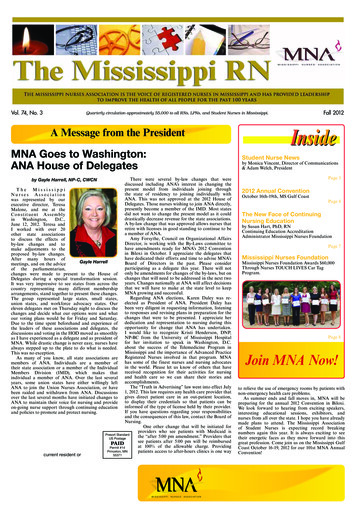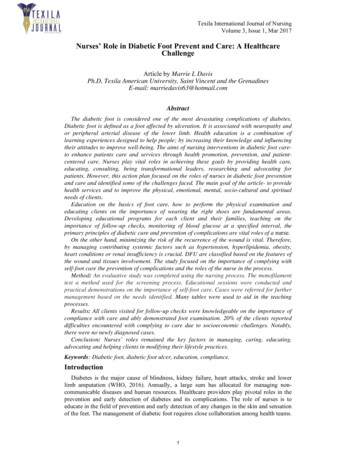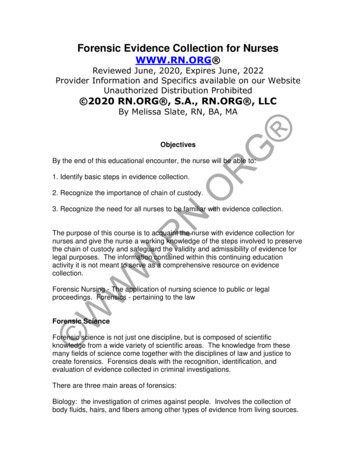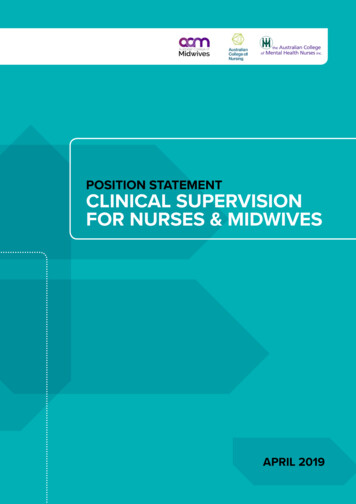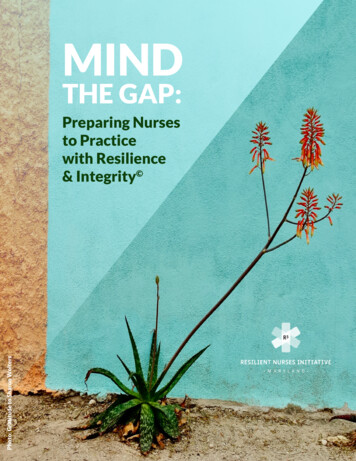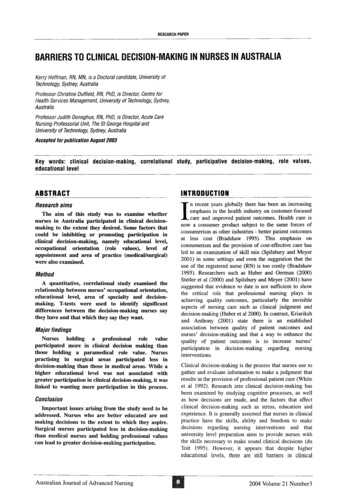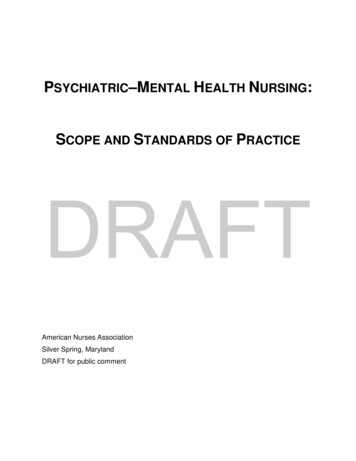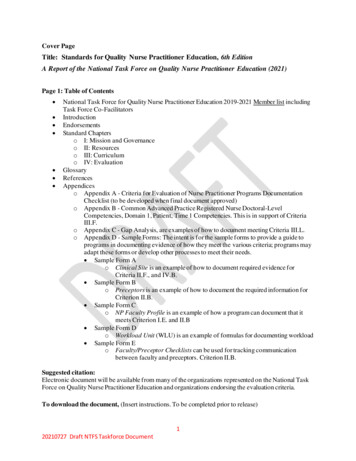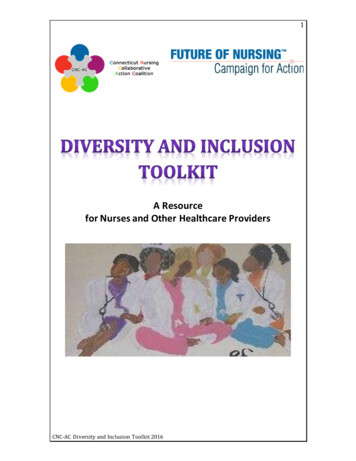
Transcription
1A Resourcefor Nurses and Other Healthcare ProvidersCNC-AC Diversity and Inclusion Toolkit 2016
2As nurses and other healthcare providers, our interests lie in improvinghealth practices to better serve our communities. Practicing culturalcompetence in academic settings, healthcare practice organizations, andthrough leadership will improve the care we provide to diversecommunities.This toolkit provides information, resources, and steps to deepenacknowledgement, exploration, and ongoing development of strategiesthat will broaden and improve diversity and inclusion for professionalpractice in clinical and education settings.Please use this toolkit as a reference and an inspiration to ignite yourprofessional journey and the journey of your organization toward amore diverse and inclusive nursing and healthcare environment whereall can flourish.In health,Connecticut Nursing Collaborative-Action Coalition Diversity CommitteeChairpersons:MaryAnn Perez-Brescia, RN, MSN, PhD(s), Jonas Scholar, Associate Professor Three RiversCommunity CollegeDenise Bell, MPH, RNDiversity Committee Members:Liz Beaudin, RN, PhD, Senior Director Nursing, Health, and Workforce CT Hospital AssociationMaria D. Krol, DNP, MSN, RNC-NIC, Assistant Professor Southern CT State UniversityFlorence Johnson, RN, MSN, MHA, Consulting Manager QualidigmKimberly Sandor, RN, MSN, FNP, Executive Director CT Nurses AssociationMarie Spivey, RN, EdD, MPA, Vice President of Health Equity CT Hospital AssociationConnecticut Nursing Collaborative-Action Coalition Statewide DirectorLisa J. Sundean, RN, MSN, MHA, PhD(c), Jonas ScholarConnecticut Nursing Collaborative-Action Coalition Co-LeadsMarcia Proto, M.Ed., CAS, Executive Director CT League for NursingKimberly Sandor, RN, MSN, FNP, Executive Director CT Nurses AssociationJill Watson, Manager of Special Grants and Projects, Workforce AllianceConnecticut Nursing Collaborative-Action Coalition RWJF SIP3 Grant Principal InvestigatorCarole H. Bergeron, RN, PhD, Academic Program Manager, Healthcare MBA Post University9/2016CNC-AC Diversity and Inclusion Toolkit 2016
3Diversity and Inclusion:Introduction .pp. 4-5Is Your EducationalInstitution Diverse andInclusive? .p. 6Diversity in the NursingWorkforce .pp. 7-10Leadership Diversity .pp. 11-12Additional References .pp. 13-15About CNC-AC .pp. 16-17CNC-AC Diversity and Inclusion Toolkit 2016
4 What is DiversityDiversity recognizes that each person is unique with differentperspectives, identity, and points of view. Diversity includesimportant and interrelated dimensions of human identity such asrace, ethnicity, color, gender, socio-economic status, nationality,citizenship, education, geographic origin, religion, sexual orientation,ability, age, political beliefs, and/or other cdi/index.php What is InclusionThe practice of inclusion, sometimes also referred to as socialinclusion, means that all people should feel valued, be respected fortheir differences, and have their basic needs met in a safe, positive,and nurturing environment. Inclusive environments allow people tolive where they are treated with dignity and respect, where they havethe opportunity to participate fully, and where they have a voice sothat they can influence decisions that affect dex.phpIf preconceived myths and stereotypes are believed to be true, even generalbiases can impact the care provided to certain populations (Trawalter,Hoffman & Waytz, 2012).Self-assessment can raise awareness about biases and support changes towardmore inclusive environments. Self-assessment can guide development of strategicplans for more inclusive educational institutions for faculty and students.CNC-AC Diversity and Inclusion Toolkit 2016
5 What Do You Assume?https://www.youtube.com/watch?v epuTZigxUY8A good way to begin understanding diversity and valuing differences is to conduct aself-assessment. Self-assessment can begin by completion of a set of questionsdesigned to identify unconscious bias. Organizational assessment can be conductedby answering questions regarding practices that support diversity and inclusion inthe workplace. Examples of such assessments include:Implicit Association Test (IAT) – Project Implicit – mplicit/takeatest.htmlLevels of RacismSource: Jones, C.P. (2000). Levels of Racism: A Theoretic Frameworkand a Gardener’s Tale. American Journal of Public Health. Vol. 90, No. 8. pp. 12121215. Retrieved 46334/pdf/10936998.pdfWhite PrivilegeSource: McIntosh, P. (1988). White Privilege: Unpacking the Invisible Backpack.Retrieved from https://www.sinsinawa.org/peace-justice/white privilege.pdfCNC-AC Diversity and Inclusion Toolkit 2016
6Institution Assessment:o Does the mission of your educational institution explicitly identifydiversity as an educational priority?o How is the mission carried forward into goals and action plans?o How many underrepresented/diverse voices are at the decisionmaking table?o How does the administrative leadership demonstrate support fordiversity initiatives?o How does the administration positively assess and monitor climateissues?o What approaches have been developed to create a positive campusclimate?o How are the outcomes measured?o Does the institution have a dedicated diversity and equity officer oroffice?o What types of assessments or strategies are still needed?National League of essionaldevelopment-programs/diversity toolkit.pdf?sfvrsn 4Resourceso as.aspo ralcompetencyo hpo l-developmentprograms/diversity toolkit.pdf?sfvrsn 4o lo http://www.racialequitytools.org/homeCNC-AC Diversity and Inclusion Toolkit 2016
7Nursing is the nation’s largest healthcare profession. According to the Henry J.Kaiser Family Foundation, there are 3,963,844 total professionally active nurses inthe United States and in Connecticut over 54,00 professionally active nurses, bothregistered nurses and licensed practical nurses.Source: Retrieved from rednurses/Healthcare is changing and population demographics are changing. We mustrecognize the relationship between a culturally diverse nursing workforce and theability to provide quality, culturally competent patient care.The need to attract students from underrepresented groups innursing – specifically men and individuals from African American,Hispanic, Asian, American Indian, and Alaskan Native backgrounds is a high priority for nursing profession.Source: American Association of Colleges of Nursing (2013). Fact sheet: Enhancingdiversity in the nursing workforce. Retrieved rsityFS.pdfCNC-AC Diversity and Inclusion Toolkit 2016
8Diversity in the Workplace: Benefits, Challenges and Solutions.Source: Greenberg, J. (2004). Retrieved enges-solutions.aspEmbracing a diverse nursing workforce.Source: Walden, P. (2013). Embracing a diverse nursing workforce. Nursing MadeIncredibly Easy!: Volume 11 - Issue 1 - p 4. Retrieved asy/Fulltext/2013/01000/Embracing a diverse nursing workforce.2.aspxFaces of Diversity. o/Source: Connecticut Multicultural Health Partnership. Retrieved video/Increasing Racial/Ethnic Diversity in Nursing to Reduce Health Disparities andAchieve Health Equity.Source: Phillips, J. M., & Malone, B. (2014). Increasing Racial/Ethnic Diversity inNursing to Reduce Health Disparities and Achieve Health Equity. Public HealthReports, 129(Suppl 2), 45–50. Retrieved fm?articleID 3081Websites Cultural Competence, Diversity, and Inclusion ex.php Robert Wood Johnson Foundation. (Keyword: nursing diversity)http://www.rwjf.org/en.htmlCNC-AC Diversity and Inclusion Toolkit 2016
9 U.S. Department of Health and Human Services Office of Minority Health.http://minorityhealth.hhs.gov/List of Diverse Nursing Organizations American Assembly for Men in Nursinghttp://www.aamn.org/ Asian American/ Pacific Islander Nurses Association. Inc.http://aapina.org/ Association of Black Nursing Faculty, Inc.http://www.abnf.net MinorityNurse.comhttp://www.minoritynurse.com National Alaska Native American Indian Nurses Associationhttp://nanainanurses.org/ National Association of Hispanic Nurseshttp://www.nahnnet.org National Association of Indian Nurses of Americahttp://www.nainausa.com/ National Black Nurses Association, Inc.http://www.nbna.org National Coalition of Ethnic Minority Nurse Associationshttp://www.ncemna.org Philippine Nurses Association of America, Inc.CNC-AC Diversity and Inclusion Toolkit 2016
10http://www.mypnaa.org/CNC-AC Diversity and Inclusion Toolkit 2016
11There are a variety of ways to define and describe diversity, but some descriptors,offered by Frederick D. Hobby, former President of the Institute for Diversity inHealth Management defines diversity as“ any collective mixture characterized by similarities and differences”;“Diversity affects everyone, is more than gender, age, racial classification, ethnicity,physical ability and sexual orientation, and determines how each individual thinks,behaves, and believes”;“It is the lens through which we see the world and encompass all the influences thatshape the way we approach work and daily living.”Implication for Population HealthDiversity within the leadership of healthcare organizations and systems providesfor multiple perspectives and thus greater ability for quality decision-making.Moreover, it stands to reason that when Board members, senior leaders, and thehealthcare workforce overall, reflect the communities they serve, an understandingof community need, development of trust, and the ability to engage in partnershipsto ensure health equity are fostered.Healthcare leadership that is diverse and engaged with its community is supportiveof organizational cultural competence that is associated with improved healthoutcomes and fewer healthcare disparities. In today’s transforming healthcareenvironment, engagement with the community, the development of patient medicalhomes, and focus on preventive health, are essential to assist populations/membersof the community to live healthy lives.The National Center for Cultural Competence (NCCC): GeorgetownUniversityThe mission of the NCCC is to increase the capacity of healthcare and mentalhealthcare programs to design, implement, and evaluate culturally and linguisticallyCNC-AC Diversity and Inclusion Toolkit 2016
12competent service delivery systems to address growing diversity, persistentdisparities, and to promote health and mental health equity.Source: Retrieved from http://nccc.georgetown.edu/The NCCC utilizes foundations of cultural and linguistic competence based on thework of Cross et al. (1989).Source: Retrieved from ross et al. (1989). Towards a Culturally Competent System of Care: A Monographon Effective Services for Minority Children Who are Severely Emotionally Disturbed.Source: Retrieved from AC Diversity and Inclusion Toolkit 2016
13Additional ResourcesAONE Guiding Principles for Diversity in Health Care ity.pdfA Guide to Planning and Implementing Cultural Competence Organizational Self /ncccorgselfassess.pdfBecoming a Culturally Competent Healthcare y-competentBest Practices or Best Guesses? Assessing the Efficacy of Corporate AffirmativeAction and Diversity Policies.https://www.cfa.harvard.edu/cfawis/Dobbin best practices.pdfBridging the Cultural Divide in Health Care Settings The Essential Role of CulturalBroker ural Broker Guide English.pdfCLAS SStandardsBlueprint.pdfClosing the Gap in Healthcare Leadership Diversity: A Witt Kieffer sity%20Final(1).pdfCorporate Leadership: Building Diversity into the unique/2009/08/diversity.aspxCultural Competency Assessment Tool for Hospitals (CCATH): Assessing Adherence tothe CLAS CCATHOverview.pdfCultural & Linguistic Competence at Meetings and Conferences.CNC-AC Diversity and Inclusion Toolkit 2016
14http://nccc.georgetown.edu/documents/Planners Guide.pdfDiversity and Disparities: A Benchmark Study of U.S. Hospitals nnection/leadershipconferences/diversity disparities Benchmark study hospitals 2013.pdfGoode, T. (2001). Policy Brief 4: Engaging communities to realize the vision of onehundred percent access and zero health disparities: A culturally competentapproach. Retrieved from dfHospital-Based Strategies for Creating a Culture of Healthwww.hpoe.org/cultureofhealthInstitute for Diversity in Healthcare ging an Intergenerational Workforce: Strategies for Healthcare al-workforceManaging Diversity from a Leadership ewsletters?find 13302National Center for Cultural Competence: Georgetown essments.htmlNational Standards for Culturally & Linguistically Appropriate Services in Health &Health Care (National CLAS /content/clas.aspNational Standards for Culturally and Linguistically Appropriate Services in Healthand Health Care: A Blueprint for Advancing and Sustaining CLAS Policy and PracticeApril EnhancedCLASStandardsBlueprint.pdfPlanning, Implementing and Evaluating Culturally Competent Service DeliverySystems in Primary Health Care Settings: Implications for Policy Makers ents/Getting Started.htmlStrategies for Leadership: Does Your Hospital Reflect the Community it iciency%20Assessment%20Tool.pdfTransition Cultural and Linguistic Competence Checklist for Medical Home Teams.CNC-AC Diversity and Inclusion Toolkit 2016
15http://nccc.georgetown.edu/documents/NCCC Transition Checklist.pdfWhy Diversity e StudiesDiversity in Healthcare Examples from the aha.org/content/16/eoccaseexamples.pdfCNC-AC Diversity and Inclusion Toolkit 2016
16AboutConnecticut Nursing Collaborative-Action CoalitionConnecticut Nursing Collaborative-Action Coalition is one of 51 Action Coalitionsand backed by 2 successive grants from the Robert Wood Johnson Foundation. CNC AC and other Action Coalitions throughout the country are part of The Campaign forAction: The Future of Nursing an initiative of the Robert Wood Johnson Foundationand AARP aiming to improve health and healthcare in the United States throughnursing.CNC-AC partners with many organizations throughout the state to achieve its goals .Examples of CNC-AC’s outcomes include: Advancing pathways for seamless academic progression by adopting theNurse of the Future Core Competency Model in most nursing programs in thestate and forging academic/practice relationships.Influencing adoption of a standard nursing education curriculum in the CTstate colleges and universities based on the Nurse of the Future CompetencyModel.Influencing the adoption of the Nurse of the Future Competency Model forstandardization of CT hospital nurse on-boarding processes and residencyprograms.Partnering with state agencies to implement electronic re-licensure fornurses, and to capture and analyze critical nursing workforce data to informlabor decisions.Promoting population health by developing an innovative online popula tionhealth education program for incumbent nurses in practice and academia,and for nursing students at all levels.Supporting implementation of an innovative online nursing educationadvisement portal through the CT League for Nursing.Supporting CT Nurses Association for expansion of CT nursing scope ofpractice laws for Advanced Practice Nurses.CNC-AC Diversity and Inclusion Toolkit 2016
17 Partnering with the Northern CT Black Nurses Association to advancediversity in the nursing workforce through support of the NCBNA MentoringProgram.Supporting diversity in the nursing workforce at the New England MinorityNurse Leadership Conference.Promoting nursing leadership by supporting Jonas Scholars and the CTNurses Association Legislative Day and annual Convention.Supporting the growth and development of new nurses by supporting the CTLeague for Nursing Annual Student Day.Promoting the role for nurses on boards in alignment with the Nurses onBoards Coalition.Visit us: www.cnc-ac.orgCNC-AC Diversity and Inclusion Toolkit 2016
Liz Beaudin, RN, PhD, Senior Director Nursing, Health, and Workforce CT Hospital Association Maria D. Krol, DNP, MSN, RNC-NIC, Assistant Professor Southern CT State University Florence Johnson, RN, MSN, MHA, Consulting Manager Qualidigm Kimberly Sandor, RN, MSN, FNP, Executive Director CT Nurses Association



